 Leading Blog | Posts by Month |
 Leading Blog | Posts by Month |
08.31.23

LeadershipNow 140: August 2023 Compilation
See more on
Posted by Michael McKinney at 12:49 PM

Leading Thoughts for August 31, 2023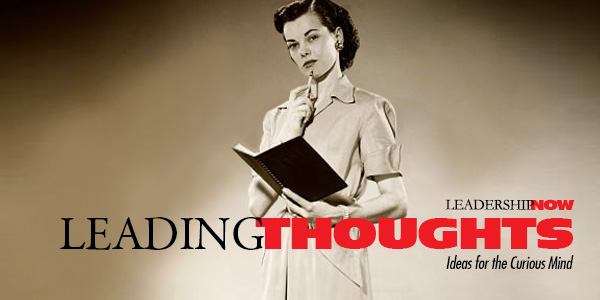
IDEAS shared have the power to expand perspectives, change thinking, and move lives. Here are two ideas for the curious mind to engage with: Associate Professor Tod Bolsinger on leading change: “Groups are hardwired to believe that survival usually means reinforcing the way things have always been. So when an organization feels stress, the default behavior of most organizational leaders is to solve the problems for our organizations rather than change our organizations for meeting the needs of the world. The result is that instead of undergoing transformation to be more effective in our mission to serve the world, organizations unconsciously reinforce the very status quo that is not working.” Source: Tempered Resilience: How Leaders Are Formed in the Crucible of Change Science journalist Mark Buchanan on great individuals: “What makes an individual notable and ‘great’ is his or her ability to unleash pent-up forces—the will of an age—and so enable those immeasurably greater forces to have their effect.” Source: Ubiquity: The Science of History . . . or Why the World Is Simpler Than We Think Look for these ideas every Thursday on the Leading Blog. Find more ideas on the LeadingThoughts index.
Posted by Michael McKinney at 06:03 AM
08.30.23

When a Success Formula Hardens
THERE IS danger when success goes to a leader’s head. King Solomon wrote, “Pride goes before destruction and a haughty spirit before a fall.” When this happens, they are at risk for what Donald Sull calls in Revival of the Fittest, active inertia. He explains what happens: Managers get trapped by success, a condition that I call active inertia, or management’s tendency to respond to the most disruptive changes by accelerating activities that succeeded in the past. When the world changes, in other words, they respond with more of what worked before. 
Posted by Michael McKinney at 09:44 AM
08.25.23

The Art of Clear Thinking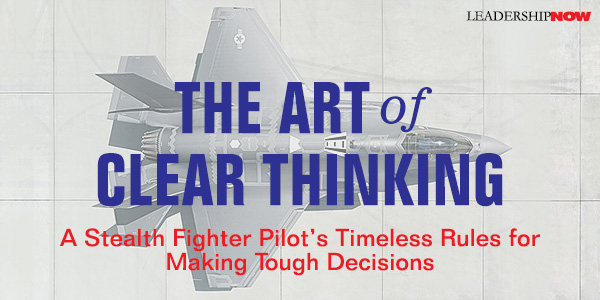
FIGHTER PILOTS must make thousands of decisions, often with incomplete information during each flight. U.S. Air Force fighter pilot and Chief of Training Systems Hasard Lee helped develop a program to boost pilots’ critical thinking skills and mental toughness to skew the odds in their favor when making these critical decisions. He passes the lessons learned on to us in The Art of Clear Thinking. Understanding how our decisions are made and how they can be improved going forward is essential with high-stakes decisions, but it is also important in our business and personal lives. The right approach to decision-making can save us a lot of regret down the road. He organizes his experience and training into a concept they call the ACE Helix. It has three parts: Access, Choose, and Execute. It is designed to bring out the best options while remaining flexible in ever-changing circumstances. 1. Assess the Problem Lee spends a lot of time explaining this step as the foundation for the success of the other two steps. “Developing a proper understanding of the problem is the first step to solving it. Our instinct is often to bypass this critical step and begin acting.” If we aren’t solving the right problem, we can make the right decision. It is important to keep the big picture in mind and not focus on just one piece of information. This is the ability to “make sense of a chaotic environment while simplifying and structuring information. This requires judgment, and judgment requires non-linear thinking. Often, our actions don’t result in a single outcome. Instead, they can lead to outsized outcomes that go beyond our imagination. They are non-linear outcomes. “For a multitude of reasons, people consistently fail to account for them, which often leads to a skewed assessment of the problem they’re facing and results in a poor decision.” These non-linear relationships are governed by power laws that can lead to exponentially greater or encompassing outcomes than we anticipated, which Lee explains in the book. “We become accustomed to how our actions are affecting a system, and then suddenly, the outcome is much different from what we were expecting. It helps if we have a broad understanding of the probable consequences of our decisions. We can adapt more quickly and accurately to changing circumstances. We can move our thinking beyond a narrow set of conditions. Lee talks about the approach they have during fighter training that all too often goes against the approach we have and certainly have experienced throughout our life. He says, “Our job wasn’t to weed them out but to coach them throughout each training event so that they could leave as the best possible pilots.” We tend to eliminate to try to cultivate the best and brightest. He adds, “We found that almost everything is coachable and correctable if identified early enough. Even supposedly intangible attributes, such as attitude, work ethic, and flying instinct, can be significantly improved if coached properly.” 2. Choose the Correct Course of Action To find the best solution, simplify. They use a technique called fast-forecasting. It is designed to build a mental model of the problem focusing on the few variables, due to strong power laws, that drive the system. This allows you to quickly approximate a ballpark solution. “We’re starting with the big-picture concept and slowly adding in detail until we have a good enough resolution to make a decision.” The key to fast-forecasting is to not get overwhelmed by the details—logic and reason are what drive the technique. Precision is often the enemy of conceptual thinking. What we’re trying to do is bring to bear the mental framework that we’ve accumulated over our lifetimes to estimate the expected value of a decision. If we instead make the problem overly complex, we lose the ability to quickly manipulate the relevant information through the lens of our concepts, principles, heuristics, and facts. Lee writes, “Creativity is one of the few resources that can provide an exponential advantage to those who are able to harness it.” Encourage creative decision-making with an effects-based approach. Start with the desired outcomes and work backward. “Breaking down the requirement into effects needed gives us at least an opportunity to explore alternative solutions.” Our desire to quickly find an answer or solution can lead us to jump to a solution that we are familiar with that might have worked in the past but is not really relevant to the current circumstance. 3. Execute Good execution requires the management of stress and, emotional control – and resilience in the face of failure. “While stress exposure can slightly increase performance for simple, well-rehearsed tasks, it severely reduces performance for tasks that require complex or flexible thinking.” Mental toughness is a skill that can be learned and improved. In fighter training, they incorporate a number of concepts into their training. Preparation is key. Mental toughness needs to be practiced until it is a subconscious reflex. They also include focus-based training. “The key to maximizing our mental resources is to focus only on what we have control over, which is the next decision to make.” Part of the training involves systematically building confidence. Confidence is not something you have, or you don’t. “Confidence is a skill that can be improved, primarily through our internal dialogue—how we talk to ourselves.” Perfectionism and focusing on our mistakes creates self-doubt, which is detrimental to high-stakes decision-making. Trainees are taught to reframe and replace negative self-talk with a successful counterexample from their past. In stressful and uncertain moments, it is important to keep your priorities your priorities. Focus on and prioritize what is important. “If there isn’t a clear vision, our minds will default toward urgent tasks.” At some point, you have to be decisive. You’ll never make the perfect decision. You can remove all uncertainty from your decision-making. When making decisions, “we’re just trying to remove the choices that are clearly not optimal.” Lee says that “when there are multiple seemingly equal choices,” he has found that “going with the riskiest viable option usually provides the greater return in value. Most people hate uncertainty, particularly when it’s combined with risk. As humans, we are biologically programmed to overestimate risk. If you’re able to overcome that mental hurdle, it becomes easy to differentiate yourself and greatly increase your odds of success.” The Art of Clear Thinking is full of great stories to illuminate the concepts and makes this business book read like a gripping novel. He shares a lot of information, so you will need to go back and reflect on how it can best be applied to your tough decisions. 
Posted by Michael McKinney at 04:39 PM
08.24.23

Leading Thoughts for August 24, 2023
IDEAS shared have the power to expand perspectives, change thinking, and move lives. Here are two ideas for the curious mind to engage with: Architect Frank Gehry on curiosity: “Question everything. Curiosity is the lifeblood of creativity. Growing up as a Jew, I studied the Talmud, which continually poses questions. This was the foundation for my way of thinking. I continually ask, ‘Why do we have to do it this way? Can’t it be done this way?’ This trait has been critical to my work.” Source: Getting There: A Book of Mentors by Gillian Zoe Segal Stonyfield Co-founder Gary Hirshberg on challenging the status quo: “Think on your own and question authority. Authority is a short-lived phenomenon. It’s who is in charge now, but that doesn’t mean that they are right. So-called experts are often wrong. Also, just because something has been done one way for many years doesn’t mean that it can’t be altered. Challenging conventional wisdom can be scary, but most major changes happen because someone asked: ‘Why not do it differently?’ If you don’t ask, you don’t get.” Source: Getting There: A Book of Mentors by Gillian Zoe Segal Getting There: A Book of Mentors by Gillian Zoe Segal is a collection of 30 unfiltered essays by successful people and their path to get there. It is a valuable resource illuminating the often-rocky road to success. Look for these ideas every Thursday on the Leading Blog. Find more ideas on the LeadingThoughts index.
Posted by Michael McKinney at 06:26 AM
08.18.23

Are Relationships Your Top Work Priority? Here’s Why They Should Be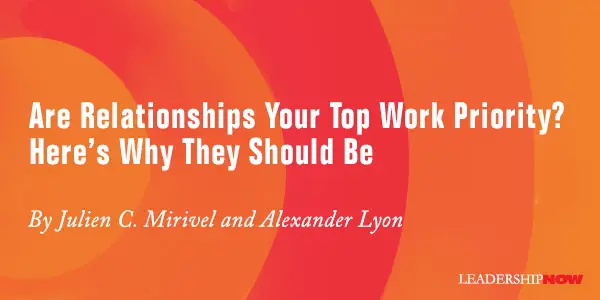
IT’S AN AMAZING FEELING: When you walk into Rob Ulmer’s office, he instantly lets go of whatever he’s doing. He turns to you with a warm greeting and gives you his undivided attention. As colleagues who worked under Rob’s leadership for years, we can’t recall a single instance when we felt pushed out, nudged to leave, or disengaged. Rob simply gives you his full self. He’s a master at creating high-quality moments for his people. Today, Robert Ulmer is dean of the Greenspun College of Urban Affairs at the University of Nevada, Las Vegas (UNLV). Originally from Canada, Rob is a leader who brings enthusiasm, positivity, and a total commitment to people—all day, every day. We interviewed him recently for our book, Positive Communication for Leaders, to understand how he does it. “As a leader, I have to be sensitive to the human equation,” Rob explained on a Zoom call. “People really do matter to me,” he added. “You’re hiring people, and you have to give them time and attention. You have to be interested in who they are and what they’re about. You have to care.” “People signal to you whether you matter or not, whether they’re more interested in you or more interested in themselves,” he explained. He briefly paused and added: “I know what that feeling is like when people don’t care about you, and I don’t want [anyone I work with] to have that feeling.” “The default for most people,” Rob continued, “is to be impersonal. Many people will treat others transactionally. It’s very easy to focus on the role and the position. Everybody will tell you that you can’t take the time to spend with people, that it’s about something else.” He paused for clarity. “That’s all nonsense,” he said as he shook his head. “Investing in relationships can be done at all leadership levels.” In the interview, we stepped in and played devil’s advocate. We argued that most people would say, “I can’t do that all the time. I’ve got emails to attend to, another meeting to go to.” What about all the things that could take a person away from the encounter? Rob responded, “Out of all the things you’ve mentioned, what could be more important than the person you have with you in that moment?” Relationships Should Be a Leader’s Top Priority Rob’s rhetorical question reveals the mindset that drives his approach to work. As he put it in the interview: “Relationships are the most important priority.” There’s nothing above that. From Rob’s vantage point, there’s no internal leadership conflict about his priorities. He’s living his principles. “I’m not using a focus on relationships as a way to get to some other outcome,” Rob concluded. “The end outcome is the relationship.” With this philosophy in mind, Rob makes lots of small and big decisions that bring this philosophy to life. At one point in the conversation, he reflected, “Sure, we have a whole bunch of problems today. We’ll have them tomorrow. I don’t go to work with the expectation that I’m going to have a perfect day. So, when I’m talking to people, I go in and have those meaningful conversations for as long as it takes. Those other extraneous issues don’t really matter. What gets us where we’re going is the relationships that we’re developing.” What can you do today to build on Rob’s approach and create quality moments with others? Here are some easy-to-do strategies you can implement today:
Positive leaders draw on the fundamental understanding that leadership is about relationships. It’s based on the process of initiating contact with people, getting to know them, enjoying those interactions, and being fully present with them. Saying hello, catching up with people, sharing jokes, and updating others about our lives collectively weave the fabric of our relationships, create mutual understanding, and increase our influence as positive leaders. And when you do that, you can create an amazing feeling.  
Posted by Michael McKinney at 05:53 AM
08.17.23

Leading Thoughts for August 17, 2023
IDEAS shared have the power to expand perspectives, change thinking, and move lives. Here are two ideas for the curious mind to engage with: Martin Moore on why leadership is hard: “Leadership is hard because, more than anything else, it’s about people. Most of us struggle to manage ourselves: our subconscious drivers, our relationships, our emotions, our mental health, our habits. Leadership demands not only that we master ourselves, but also that we become strong enough and capable enough to help others do the same.” Source: No Bullsh!t Leadership Steven Kotler on achieving the art of the impossible: “Motivation is what gets you into the game; learning is what helps you continue to play; creativity is how you steer; and flow is how you turbo-boost the results beyond all rational standards and reasonable expectations.” Source: The Art of Impossible: A Peak Performance Primer Look for these ideas every Thursday on the Leading Blog. Find more ideas on the LeadingThoughts index.
Posted by Michael McKinney at 05:43 AM
08.16.23

Do You See Me?
PEOPLE want to feel seen. We all do. We want to know, “Do I matter?” We want to know that the leader is invested in us. As leaders, it becomes a matter of how we treat others. Do we include them in meaningful action? Do we listen? Do we care about their future? Leaders who have a developmental focus make others feel seen. Interactions are not seen as transactional. In The Extraordinary Power of Leader Humility, Marilyn Gist states, “Developmental focus implies long-term thinking. You care about the whole person and his or her progress beyond what is merely useful to you.” She explains: The power you can hold can be used to support others’; growth, neglect it, or sabotage it—and they are aware of this. Your role as a leader can and should involve helping them in many ways, such as understanding the values of your specific organizational culture, how to do their job better, how to improve their knowledge of the context in which you operate so they have a better chance to advance, and how to manage others. Barbie Brewer was hired at IBM in her early twenties to manage the internship program in eleven western states. She writes in Lead and Let Live, “The job at IBM also represented the first time a company invested in me, that is made me feel a valued and valuable member of the team. They flew me out to their headquarters in White Plains, New York, for extensive training, taking a chance on this rookie because they saw something in me that I hadn’t yet seen in myself. Leaders, listen up: investing in your young people and giving them solid training is the smartest thing you’ll ever do.” In a similar way, when I was 22, I worked for Hughes Helicopters as a Cash Management Analyst. At the time, our multi-million-dollar contracts were paid monthly with mailed checks. The impact on our cash flow and potential overnight investments was huge. They sent me to Warren, Michigan, to work with the Department of Defense to streamline the monthly payment process of our AH-64 Apache Advance Attack Helicopter development. They also sent me to New York to do the same with the governments of Israel and Kenya to streamline their payments for other helicopter programs. Their trust in me expanded my capacity and built my confidence and commitment to Hughes. It is important for leaders to give others the space to think for themselves and take the initiative in the parameters of the culture. No one knows it all, and we dignify and value others by including and stretching them. To do this is to believe that everyone is valuable enough to contribute to the organization’s success. Before we can truly lift others up, we need to examine our beliefs about other people. How we regard ourselves in relation to others will determine how we treat them in the long run.
Posted by Michael McKinney at 06:44 AM
08.14.23

Get Out of Your Own Way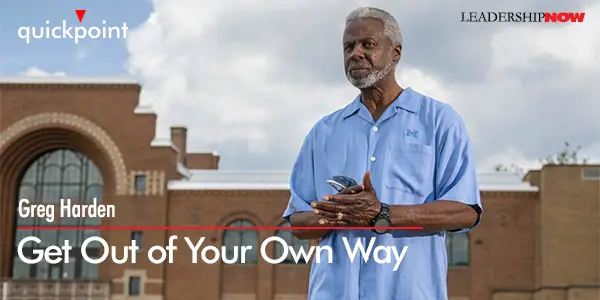
RETIRED University of Michigan, Director of Athletic Counseling Greg Harden asks us to learn how to get out of our own way. Stop for a moment and think about your own life. What’s holding you back? How often are you… … your own worst enemy?
Be honest with yourself about what’s holding you back. “This will only increase your commitment to the ultimate mission: Learn how to control the controllables. Practice, train, and rehearse controlling your own thoughts and actions.” You are the only person who has control over your own mind. Commit to staying out of your own way every day. 
Posted by Michael McKinney at 06:51 AM
08.11.23

Stay Sane in An Insane World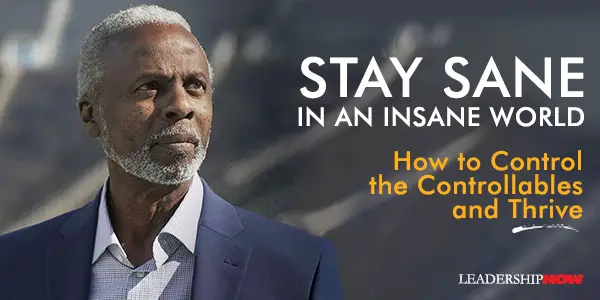
BECOME your own best friend. “I can’t teach Tom Brady how to throw a ball,” says Greg Harden. “I can’t teach Desmond Howard how to catch the ball. I can’t teach Michael Phelps how to do a perfect flip turn. All I can do is teach you how to become the world’s greatest expert on one subject: yourself.” The former University of Michigan Athletic Counselor Greg Harden has worked with world-class athletes like Tom Brady, Michael Phelps, Desmond Howard, and hundreds of business leaders and professionals from all walks of life and shares the cumulative wisdom from working with them in Stay Sane in An Insane World: How to Control the Controllables and Thrive. How do you become your own best friend? There are three things high-performers have in common. First of all, be coachable. “The first thing that Tom Brady and Desmond Howard had in common is that they were hungry for input, hungry for information, hungry to learn.” Second is their belief in the process of self-improvement. “It’s a three-step process in which you commit to doing what it takes to make yourself better, then you do the hard work to improve your performance in EVERYTHING you do, and then you maintain that performance over time.” The third thing is an intangible Harden calls the edge or an extra gear. It’s “the ability to turn it up when you need to, even when it feels as if you were already giving 100 percent. To decide that you’re going to win. To decide that you’re going to find a way to push yourself, and everyone else around you, to another level.” The path to this place is what Harden repeats over and over: “Control the controllables.” Our ability to keep functioning, both together and as individuals, as everything gets turned upside down all around us—to focus on those things that we can control when everything else seems to be spinning out of control—is more valuable right now than it has ever been. When Tom Brady first came to Michigan, he spent a lot of time on the bench. He was discouraged, distressed, and overwhelmed. He said, “The coaches don’t believe in me.” Harden said, “You’re right. Why should they believe in you if you don’t believe in yourself.” He added, “If you believe in yourself, it doesn’t matter what anyone else thinks. You’ve got to believe, whether you are playing, starting, or sitting on the bench, that you are capable, you are qualified, and you are confident.” You want to believe that the hard work of practicing, training, and rehearsing for success will give you the right mindset to turn troubled times into valuable lessons that get you closer to your goal. “The greatest competition you’re ever going to face is yourself.” You must adapt or die. “You must train yourself to adapt to every possible circumstance, deal with any situation, use any object as a weapon to defend yourself. You adjust your thinking based on the changes that confront you. You roll with the punches. You improvise. You adapt.” Or you die. Again, the theme that runs through everything he teaches is to control the controllables. Harden says we all need what he calls the Four A’s: Attention, Affection, Approval, and Acceptance. When you think about your purpose in life and your motivations is important to keep the Four A’s in mind because “your motivations, the human desire to satisfy those basic emotional needs, are the 4 keys to understanding which of your attitudes, and behaviors are helping you achieve your goals—and which ones are holding you back.” Self-defeating attitudes and behaviors come from trying to satisfy those needs in the wrong way. Sportscaster James Brown once said on 60 Minutes that Harden was “Michigan’s Secret Weapon.” There is a lot of solid advice that can be applied to any of us in any area of life. Throughout the book are inspiring testimonials from people Harden has worked with. They share where they started mentally and then what he told them, and how his insights played out in their life and careers. Ward Manuel remembers Harden telling him that “It’s not like when something bad happens in your life, you’re supposed to stop thinking about it. It’s going to bother you; it’s going to put you back on your heels a little bit. The message is, don’t let it be the only thing that you think about. Don’t let it stop you from finding a new way forward.” Olympic gold medal winner Samantha Arsenault suffered a serious shoulder injury while training for the Olympics that threatened to take her out of the water and derail her self-image and everyone’s expectations of her as a world-class swimmer. Harden told her: “The only thing you even have a shot at controlling is how you see yourself. How you respond to this adversity. How you reframe your own thoughts. Because thoughts are real, Samantha. And the thoughts you’ve been having, how scared you are—it’s all to be expected if you’re a human being. If you are a robot, then you get a pass. Nothing to worry about, go to the shop and get your shoulder repaired. You’re good to go. But if you’re a real human being, then what does that mean? It means you’re getting tested right now. And you have the opportunity, right now, to decide what kind of person you’re going to be. You’ve got to decide that with or without your sport, your life is going to be amazing.” Michigan soccer player Michael Parke (now Professor Parke at the London Business School) was depressed over not getting time on the field, and he remembers Harden telling him, “This is not about soccer. This is about you becoming a man. Your job is to be as confident as you can be, regardless of what the coaches think of you. And to be ready, so that when your opportunity comes, you can take hold of it and never look back. Stop trying to change the coaches. Focus on what you can control. Control the controllables. Practice, train, and rehearse giving 100 percent until your coaches have no choice but to play you.” 
Posted by Michael McKinney at 06:05 AM
08.10.23

Leading Thoughts for August 10, 2023
IDEAS shared have the power to expand perspectives, change thinking, and move lives. Here are two ideas for the curious mind to engage with: John W. Gardner on building meaning into your life: “Meaning is not something you stumble across, like an answer to a riddle or the prize in a treasure hunt. Meaning is something you build into your life. You build it out of your own past, out of your affections and loyalties, out of the experience of humankind as it is passed on to you, out of your own talent and understanding, out of the things you believe in, out of the things and people you love, out of the values for which you are to sacrifice something. The ingredients are there. You are the only one who can put them together into that unique pattern that will be your life. Let it be a life that has dignity and meaning for you. If it does, then the particular balance of success or failure—as the world measures success or failure—is of less account.” Source: Living, Leading, and the American Dream Molecular biologist John Medina on work and family: “There is no such thing as a firewall between personal issues and work productivity. That’s because we can’t have two brains we can interchange depending on whether we are in our office or in our bedroom. Stress in the workplace affects family life, causing more stress in the family. More stress in the family causes more stress at work, which in turn gets brought home again. It’s a deadly, self-feeding spiral, and researchers call it “work-family conflict.” So you may have the most wonderful feelings about autonomy at work, and you may have tremendous problem-solving opportunities with your colleagues. But if your home life is a wreck, you can still suffer the negative effects of stress, and so can your employer.” Source: Brain Rules: 12 Principles for Surviving and Thriving at Work, Home, and School Look for these ideas every Thursday on the Leading Blog. Find more ideas on the LeadingThoughts index.
Posted by Michael McKinney at 05:00 AM
08.08.23

The Secret to Changing Your Culture When It Doesn’t Align with Your Strategy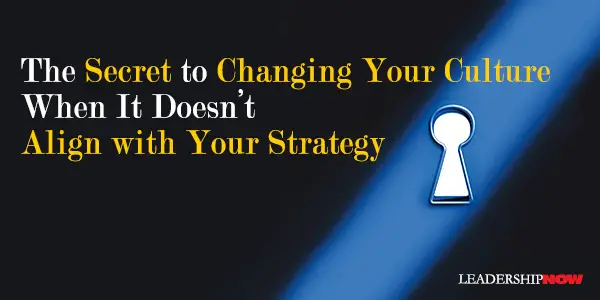
IF YOU WANT to change your culture, you need to change the stories that the people in your organization share with each other. Jay B. Barney, Manoel Amorim, and Carlos Júlio write in The Secret of Culture Change that these culture-changing stories are the secret of culture change. If you want to change your organization’s culture, start by building stories. By interviewing leaders who attempted to change their organizational culture, they collected over 150 culture-changing stories, many of which found their way into this book. From these stories, they identified six attributes of successful culture-changing stories. They go into detail to explain the six attributes of successful culture-changing stories. The stories and organizational myths that they share in each chapter are not only engaging and entertaining but instructive and worth the price of the book alone. The six attributes are: 1. The actions that these stories are built on are authentic. Authentic stories “reflect your deeply held values and beliefs about who you are as a leader, your commitment to the well-being of your employees and other stakeholders, and how these are related to the ability of your firm to implement your strategies.” 2. These stories “star” one leader. This is not to gratify your ego but to demonstrate your commitment by being the culture to want to change to. “If you are not willing to do something that will build a story in your firm to help change its culture, then it is very unlikely that your employees will believe that you are truly committed to culture change.” 3. The actions that build these stories signal a clean break with the past, with a clear path to the future. “The stories you build to change your organization’s culture have to make it clear what specific patterns of thinking, acting, and responding are no longer acceptable, and what these new patterns will be.” The story must break with the past and show a path to the future. 4. These stories appeal to employees’ heads and hearts. “Successful culture change requires both an appeal to the rational economic interests of your employees—their heads—and to their emotional and social interests—their hearts.” 5. The actions that build these stories are often theatrical. By theatrical, they mean doing something that is outside the normal in a public setting that reinforces some aspect of the cultural change. 6. These stories are told and retold throughout an organization. Stories that are “authentic that star you, that identify a clear break with the past and a path to the future, that appeal to both head and heart, and that are theatrical in nature” begin the culture-change process. The trick, then, is to enlist other members of your organization to create their own culture-changing stories or what the authors call a story cascade. The leaders profiled in this book “found the basic materials needed to build a story when their expectations about what their organization needed to do were inconsistent with what it was actually doing. Every time you become aware of a time when your organization does not deliver on its strategy, there is a possible culture-changing story there.” 
Posted by Michael McKinney at 08:24 AM
08.03.23

Leading Thoughts for August 3, 2023
IDEAS shared have the power to expand perspectives, change thinking, and move lives. Here are two ideas for the curious mind to engage with: Ray Dalio on embracing reality as indispensable to making good choices: “People who confuse what they wish were true with what is really true create distorted pictures of reality that make it impossible for them to make the best choices.” Source: Principles: Life and Work by Ray Dalio Timothy Keiningham and Lerzan Aksoy on the art of loyalty: “Loyalty by its very nature demands that we commit ourselves to a person, group, or cause. We suppress our short-term self-interests to maintain our bond. In its most noble form, we serve a cause greater than ourselves, designed to unite with another. Therefore, in our training to be loyal, we need to learn the real meaning of service to something greater than oneself.” Look for these ideas every Thursday on the Leading Blog. Find more ideas on the LeadingThoughts index.
Posted by Michael McKinney at 08:28 AM
08.01.23

First Look: Leadership Books for August 2023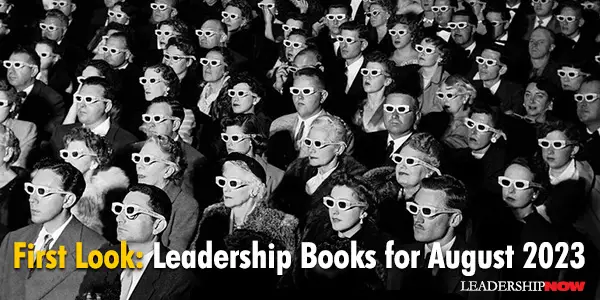
HERE'S A LOOK at some of the best leadership books to be released in August 2023 curated just for you. Be sure to check out the other great titles being offered this month.
Data indicates that most strategic efforts to change a company’s culture fail. So how do companies succeed in this endeavor? A top strategy professor and two highly successful CEOs found that, in companies that had successfully changed their culture, leaders had taken dramatic actions that embodied the new cultural values. These actions inspired stories that became company legends, repeated in every department and handed on to new employees. Through compiling and analyzing 150 stories from business leaders who have achieved change, they identified 6 attributes that every successful culture change story has in common
Greg Harden changes lives. This is why hundreds of world-class athletes, doctors, lawyers, teachers, business leaders, college students, and professionals from all walks of life have come to him for advice and direction--including 7-time Super Bowl Champion Tom Brady, 23-time Olympic Gold Medalist Michael Phelps, Heisman Trophy winners Desmond Howard and Charles Woodson, CEOs of major companies, and championship coaching staffs from all over the world. Harden teaches his students how to practice, train, and rehearse to give 100 percent, 100 percent of the time, and challenges them by asking: If you don't believe in yourself, why should I believe in you? Champions aren't born. They're built. Greg Harden spent over 30 years building them at the University of Michigan and gained national recognition when 60 Minutes Sports profiled him as "Michigan's Secret Weapon."
When our trust is broken, and when our own trustworthiness is called into question, many of us are left wondering what to do. We barely know how trust works. How could we possibly repair it? Peter H. Kim, the world’s leading expert in the rapidly growing field of trust repair, has conducted over two decades of groundbreaking research to answer that question. In How Trust Works, he draws on this research and the work of other social scientists to reveal the surprising truths about how relationships are built, how they are broken, and how they are repaired. He shows how we are often more trusting than we think and how easily our trust in others can be distorted. He illustrates these insights with accounts of some of the most striking and well-known trust violations that have occurred in modern times and unveils the crucial secrets behind when and why our attempts to repair trust are effective, and which breaches of confidence are just too deep.
Here is one of the most fundamental questions in human life: How do we decide how we decide? We make such decisions all the time. If you trust your doctor, you might decide to follow a simple rule for medical decisions: Do whatever your doctor suggests. If you like someone a lot, and maybe love them, but are not sure whether you want to marry them, you might do this: Live with them first. Some of these strategies are wise. They prevent error. They improve your emotional well-being. Some of these strategies are foolish. They lead you in the direction of terrible mistakes. They prevent you from learning. They might make you miserable. Decisions about Decisions explores how people do, and should, make decisions about decisions. It aims to see what such decisions are, to explore how they go right, and see where they go wrong.
Steven Bartlett has never been one to follow conventional rules. He’s achieved extraordinary success and emerged as one of the greatest marketing minds of our time by doing things differently. But there is a method to his maverick style. Between founding and running a global digital marketing agency, investing in over forty companies, creating a hit podcast, and launching a venture fund for minority businesses, Bartlett has learned valuable lessons about success and failure, discovering a set of principles that he uses to guide him on his journey from strength to strength. In The Diary of a CEO, he presents these thirty-three fundamental laws that will ensure excellence and help you take real steps toward achieving your most daring goals.
Maximize your leadership impact with the latest insights and research from the field of adaptive leadership. In The End of Leadership as We Know It, a team of veteran executive and leadership strategists delivers an expert analysis of the ten most common errors leaders make when attempting to address disruption and concrete strategies for avoiding them. In the book, you’ll find ways to apply the latest research in adaptive leadership and complexity to your own leadership style and achieve the impact you seek to have on your business, your followers, and yourself. The authors explain how to rethink the essence of leadership during times of flux and show you how to deal with unpredictable situations.
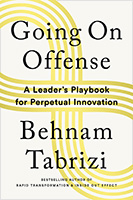 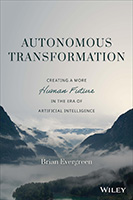 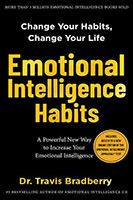 
“... a mind needs books as a sword needs a whetstone, if it is to keep its edge.” — George R.R. Martin, A Game of Thrones
Posted by Michael McKinney at 05:42 AM
|
BUILD YOUR KNOWLEDGE


How to Do Your Start-Up Right STRAIGHT TALK FOR START-UPS 
Grow Your Leadership Skills NEW AND UPCOMING LEADERSHIP BOOKS 
Leadership Minute BITE-SIZE CONCEPTS YOU CAN CHEW ON 
Classic Leadership Books BOOKS TO READ BEFORE YOU LEAD |
|